High-yielding mid-late cabbage hybrid Megaton f1 with good keeping quality
Megaton F1 is one of the best hybrids of Dutch selection. Cabbage has immunity to major crop diseases, low susceptibility to pests and frost resistance down to -8°C. High yield, suitability for pickling and excellent taste of heads of cabbage both fresh and processed make the crop especially popular.
Description of cabbage Megaton F1
Megaton is a mid-late hybrid of Dutch selection from the Bejo Zaden company. In 1996, it was included in the State Register for the Central region and recommended for cultivation throughout Russia.
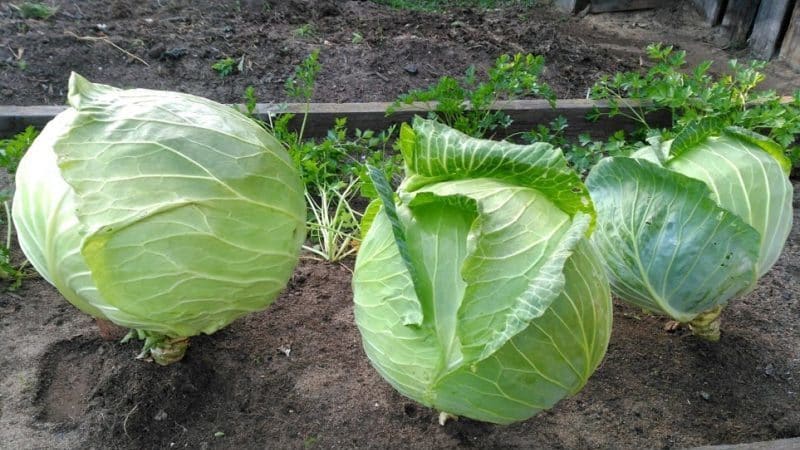
Chemical composition and beneficial properties
Vitamin content in 100 g of white cabbage:
- C - 39.3–43.6 mg;
- E - 0.02–0.1 mg;
- K - 0.08 mg;
- RR - 0.2–0.56 mg;
- U - 16–21 mg;
- beta-carotene - 0.02–0.07 mg;
- B1 - 0.03–0.08 mg;
- B2 - 0.03–0.06 mg;
- B4 - 10.7 mg;
- B5 - 0.21 mg;
- B6 - 0.1-0.2 mg;
- B9 - 0.04–0.13 mg.
Macro- and microelements per 100 g:
- potassium - 175–320 mg;
- silicon - 53 mg;
- calcium - 43–57 mg;
- sodium - 4–13 mg;
- magnesium - 16 mg;
- phosphorus - 23–41 mg;
- chlorine - 37 mg;
- sulfur - 77 mg;
- aluminum - 0.57 mg;
- boron - 0.2 mg;
- iodine - 0.003–0.015 mg;
- iron - 0.2–0.6 mg;
- cobalt - 0.003 mg;
- molybdenum - 0.01 mg;
- copper - 0.035–0.08 mg;
- manganese - 0.11–0.36 mg;
- nickel - 0.01–0.015 mg;
- selenium - 0.8 mg;
- fluoride - 0.01 mg;
- chromium - 0.005 mg;
- zinc - 0.23–0.4 mg.
Nutritional and energy value of 100 g of fresh product:
- calorie content - 28 kcal;
- carbohydrates - 4.7 g;
- proteins - 1.8 g;
- fats - 0.2 g;
- organic acids - 0.3 g;
- fiber - 2 g;
- water - 90.4 g;
- ash - 0.7 g.
Thanks to dietary fiber, potassium salts and methylmethionine, cabbage is included in a number of therapeutic diets for atherosclerosis, diseases of the stomach and duodenum. It cleans blood vessels, normalizes metabolism and removes excess water from the body. Tartronic acid prevents the formation of fatty deposits.
Useful properties of the vegetable:
- normalizes blood sugar levels, reduces cholesterol;
- strengthens gums and teeth;
- improves heart and kidney function;
- has anti-inflammatory, antibacterial and antiseptic effects;
- increases the acidity of gastric juice, promotes the healing of stomach and duodenal ulcers;
- improves appetite, accelerates intestinal motility;
- has a beneficial effect on the functioning of the nervous system.
It is not recommended to use cabbage for gastritis with high acidity, exacerbation of peptic ulcers, intestinal spasms, kidney problems, the presence of gallstones and hypertension. It is not advisable to add vegetables to the diet during lactation.
Features of application
Megaton cabbage is suitable for fresh consumption, pickling and pickling due to the following characteristics:
- bright white internal structure;
- juicy, dense heads of cabbage;
- sugar content - up to 5% per 100 g;
- great taste.
Ripening time and yield
Ripens in 135–170 days from planting. Productivity - 13–15 kg/m² or 670–950 c/ha. The maximum value (1053 c/ha) was obtained in the Moscow region.
Resistance to cold and disease
The hybrid is resistant to gray rot, fusarium wilt, clubroot and cracking of heads of cabbage.
Tolerates autumn frosts down to -8°C. The seedlings can withstand return frosts down to -5°C.
Characteristics
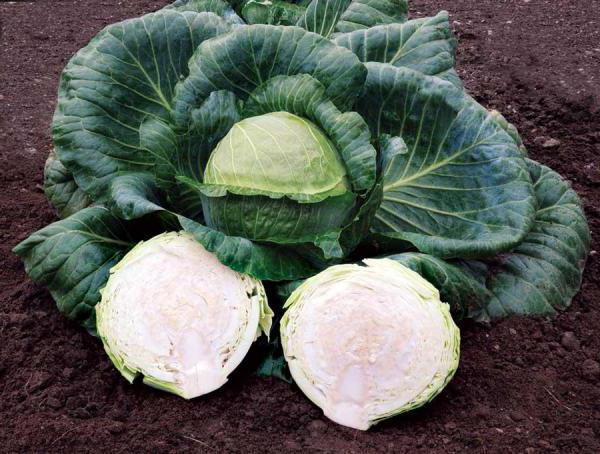
Megaton cabbage is a hybrid, not a variety, with a powerful and spreading leaf rosette with a diameter of 0.5 to 1 m. The leaves are large, round, grayish-green, with a waxy coating, wavy edges and a wrinkled surface.
The head of cabbage is hard, strong and heavy, rounded-flat and bright white when cut. The outer leaves are slightly bent. 2-3 erect rosette leaves fit tightly to the head. The pulp is juicy, crispy, with a pleasant mild aroma. The taste is sweet, without bitterness.
The length of the stem is about 15 cm. The inner stalk is short (8–10 cm), and does not reach the middle of the stalk, regardless of its volume. The average weight of a head of cabbage is 3.2–4.1 kg, the maximum is up to 15 kg. Waste after processing - no more than 7%.
Regions and climate
The culture shows high productivity in conditions of long daylight hours, sufficient soil moisture and moderate heat, therefore it is best suited for the middle zone and northern regions of Russia.
Reference. Optimal conditions for growth and formation of heads of cabbage are +15…+25°C. At temperatures below +13°C and prolonged heat above +30°C, productivity decreases.
Recommended growing regions: Northern, Northwestern, Central, Volga-Vyatka, Central Black Earth, North Caucasus, Lower Volga, Ural, Western and Eastern Siberian, Far Eastern.
Some gardeners believe that the hybrid is not recommended for industrial cultivation in the regions of the middle Volga delta due to the arid climate, but in private farms, in irrigated areas of this area, it produces a full harvest.
Advantages and disadvantages
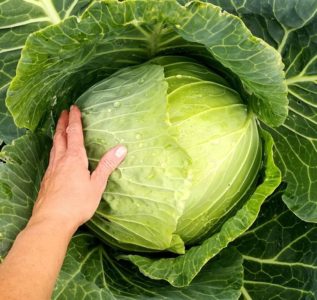
Megaton advantages:
- high productivity;
- frost resistance;
- resistance of heads of cabbage to cracking;
- immunity to major crop diseases;
- excellent taste without bitterness;
- preservation of presentation during harvest transportation.
Flaws:
- not suitable for long-term storage;
- heads of cabbage require two weeks of ripening;
- During storage there are no visible signs of rotting - the forks deteriorate from the inside.
Differences from other varieties and hybrids:
- low susceptibility to crop pests;
- resistance to temperature changes;
- no problems with the formation of heads of cabbage;
- ubiquity of cultivation.
Features of planting and growing
In regions with temperate and warm climates, cabbage is sown in open ground; in cold regions, seedlings are prepared.
Seeds for seedlings are sown from the first ten days of March to the third ten days of April. Soil composition: add 10 tbsp to a bucket of a mixture of garden soil and sand (1:1). l. wood ash.
Important! The seeds of the hybrid white cabbage Megaton F1 are processed by the manufacturer, so they are not additionally soaked in a growth stimulant and are not disinfected.
Large drainage holes are pierced in boxes and pots for seedlings. To avoid intermediate picking, use plastic cassettes and cups or large peat tablets.
Preparing seedlings
The day before sowing, the soil is poured into planting containers and spilled with a hot solution of light pink potassium permanganate.
In the boxes, grooves are made 1 cm deep in increments of 3 cm. Seeds are laid out every 2 cm and sprinkled with earth. Plant 2 seeds in cups and 1 in peat tablets. Moisten the soil with warm water from a spray bottle. The plantings are covered and placed in a warm place. The greenhouse temperature is +18…+20°C.
After 5 days, shoots will appear. The boxes are transferred to a bright, cool place with a temperature of +8…+10°C. Over the course of 3 days, the film is removed for 2 hours in the morning and evening, and on the fourth day it is removed completely.
Seedlings are provided with 12 hours of daylight. Water with warm water as the top layer of soil dries. In the cups, the weak sprout is pinched and the strong one is left.
With the appearance of the first true leaf, the temperature is raised to +15...+18°C and fertilizing is applied: 12 g of ammonium nitrate, 20 g of superphosphate and 5 g of potassium salt are diluted in 5 liters of water.
In the phase of 2 true leaves, seedlings from boxes are dived into separate cups with a diameter of 6-7 cm. Add a second feeding: mullein solution or 15 g of ammonium nitrate per 5 liters of water.
A week before transferring them to open ground, the plants are taken outside daily for 3-4 hours. 2 days before transplantation, fertilize (15 g ammonium nitrate, 10 g potassium salt, 40 g superphosphate per 5 liters of water).
Read also:
The best Dutch varieties and hybrids of white cabbage
The best varieties of cabbage for pickling and storing for the winter
Non-seedling planting
Cabbage is sown in early May in long and high beds if the constant air temperature is +10...+15°C.
Using the bottom of a glass bottle, even holes are pressed to a depth of 3-4 cm in increments of 60 cm. The width between the rows is 70 cm. A glass of water is poured into the hole, 3-4 seeds are laid out and sprinkled with earth. The beds are covered with film or a plastic bottle without a bottom is placed on each hole.
On hot days, the greenhouse is ventilated. Moisten only with a spray bottle when the top part of the soil dries.
A week after germination, the film is removed. Thin out twice: in the phase of 2 and 3 true leaves. After the second time, only 1 strong sprout is left in the hole.
Soil requirements
The soil for the hybrid should be neutral or slightly acidic, with a high organic content. Before winter, the site is dug up to a bayonet depth and fertilized with manure, humus or compost (5 kg/m²).Acidic soil is neutralized with chalk or lime. In the spring, they re-dig and loosen.
Predecessors
Favorable predecessor crops:
- cucumbers;
- zucchini;
- potato;
- green manure;
- legumes
Acceptable: onions, garlic, corn.
Bad predecessors:
Dates, scheme and rules of planting
Seedlings are transferred to open ground at the end of May, at the age of 45 days. Plants should have 6 leaves 10–12 cm long.
Important! To prevent cabbage bushes from wilting, they are replanted on a cloudy day.
Work order:
- Water the cabbage 2 hours before planting.
- The holes are made 1.5 times larger than the planting pots. Pour 2 tbsp into each. a mixture of humus and wood ash (2:1). The distance between holes is 60 cm, between rows is 70 cm.
- Transplanted using the transshipment method. The pots (cups) are removed, and the plants are placed in the holes along with a lump of earth.
- Planting holes are watered abundantly and wait for the water to subside. After this, they are covered with soil up to the lower leaves. The root zone is compacted and dusted with wood ash or mulched.
Features of cultivation
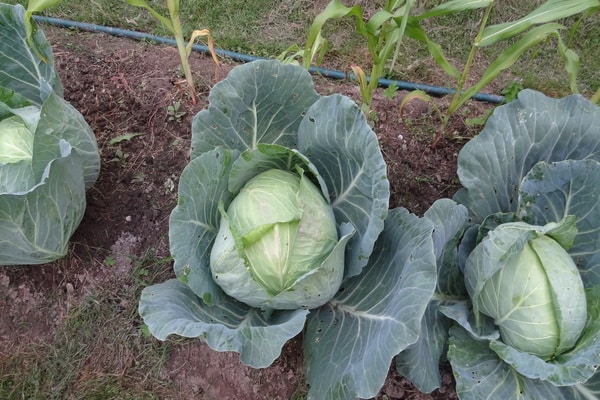
To grow green mass, cabbage requires nitrogen, and from the moment heads form, it requires potassium and phosphorus.
The crop is watered often and little by little to maintain moderate and constant soil moisture. In waterlogged or dry soil, the plant does not receive enough nutrition and begins to get sick.
Advice. The hybrid tolerates cold better than heat and drought, so in warm and dry areas, low areas are chosen for beds and the plants are watered not in the morning, but in the evening.
Megaton has large and heavy heads of cabbage, so during ripening they are supported with a brick or stone so that the plants do not fall to one side.
Top dressing
Cabbage is fertilized 2 times per season:
- 2 weeks after planting in open ground - 1 liter of liquid mullein per 10 liters of water, consumption - 0.5 liters for each bush;
- in the head formation phase - 8 g of potassium sulfate, 5 g of superphosphate and 4 g of urea per 10 liters of water, the same consumption.
Fertilizers are applied only to moist soil so as not to cause chemical burns to plants.
Watering mode
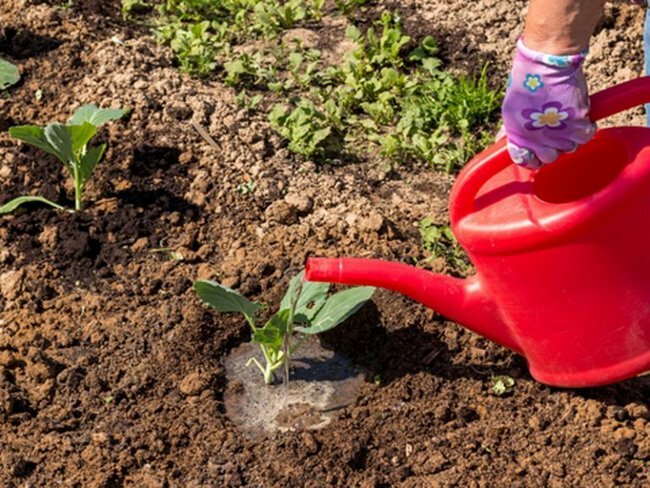
Water the cabbage in the morning or evening with warm, sun-warmed water. The first 2 weeks after planting seedlings - 8 l/m² once every 3 days. Then every 5 days. Weather conditions are different everywhere, so they focus on constant light soil moisture.
On flat areas, it is more convenient to pour water into the furrows of the rows with a depth of 10–12 cm. For relief areas, sprinkling is suitable. The optimal method is drip irrigation.
Loosening and hilling
The beds are loosened every other day after each watering or rain.
On days 20–25 after planting, the cabbage is hilled up for the first time (the soil is raked up to the stem, up to the lower leaves) and again after 20 days. This stimulates root growth, as a result the plants feed better and the forks become larger.
Measures to increase yield
In order for the heads of cabbage to gain maximum weight, Mag-Bor is added to the soil in the spring (1 tbsp per 1 m²). During fertilizing, the preparations “Gumat+7” or “Kalimag” are added to the mineral mixtures.
In the intervals between fertilizing, cabbage is sprayed 2-3 times with a complex of microelements (for example, “Tsitovit”).
Read also:
Disease and pest control
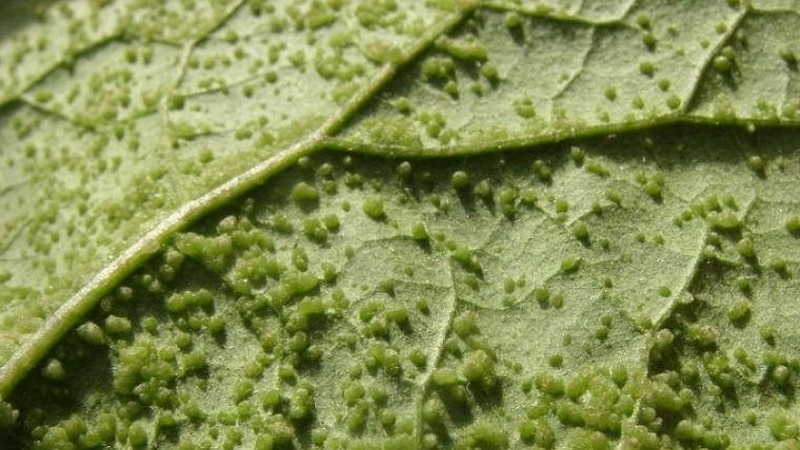
With vascular bacteriosis Cabbage leaves turn yellow at the edges. To treat plantings, they are treated with Planriz (10 ml per 1 bucket of water) 2 times with an interval of 10 days.
To combat aphids plants are sprayed with infusion of wormwood, nettle or chamomile. In case of serious damage, treat with Intavir. Watering at the root is replaced by sprinkling.
From cruciferous flea beetle the cabbage is dusted with ash, sprayed with a garlic-soap solution (100 g of soap and 300 g of infusion per bucket of water) or “Aktellik”.
Against cabbage whites Fitoverm or Intavir help. Carry out 2 treatments with an interval of 10 days.
Possible difficulties during cultivation
A common mistake novice gardeners make is watering their plants with ice water. It reduces the ability of the roots to absorb moisture, which means that the leaves do not receive enough of it. It turns out that watering is timely, but the plants weaken and develop poorly.
If the plantings are thickened, the cabbage will grow, slowly form heads, and they will turn out much smaller. The situation will be improved by thinning and additional fertilizing with phosphorus-potassium fertilizer.
Harvest and storage
The harvest is harvested at a temperature of -2°C. First, the rosette leaves are torn off. The heads of cabbage are dug up along with the roots and left for a day in the fresh air. Then the stems are cut, excess cover leaves are removed and the vegetables are transferred to the basement. Place them in boxes or on a wooden floor and let them rest. After 2 weeks, the hybrid is ready for processing.
If required, the harvest is left for storage. Keep at a temperature of -1...+5°C and air humidity 90–98% for about 3-4 months.
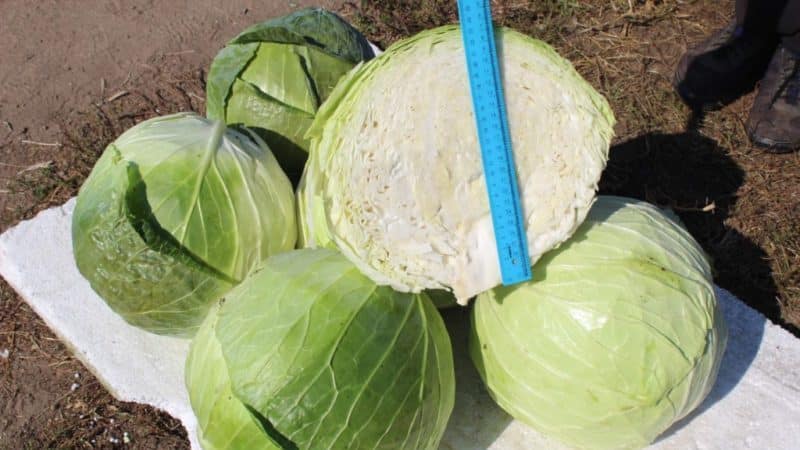
Tips and reviews from experienced gardeners
Vegetable growers admit that Megaton lives up to its name, noting the high germination of seeds and the excellent taste of vegetables.
Alexandra Petrovna, Arzamas: “I have been growing this hybrid for several years, and it has never gotten sick. The main thing is to harvest on time.If you are late with the seedlings, sow at the end of April immediately in open ground, under a film.”
Konstantin, Zaraysk: “I read the reviews and descriptions, looked at photos of different varieties - I chose Megaton cabbage. I planted it last year. There were 5 seeds in the package, all of them sprouted. Heads of cabbage - 11 kg each. There was enough for pickling for the whole season. The taste is truly amazing."
Conclusion
Megaton F1 is a high-yielding hybrid with dense and tasty heads of cabbage. The culture is insensitive to weather changes and temperature changes. This cabbage is grown throughout Russia, but the largest harvests are obtained in regions with a temperate climate. Vegetable growers highlight the hybrid as one of the best for pickling and fermentation.